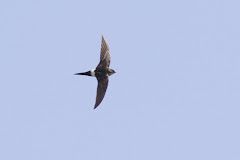With one of Libby's friends over for the weekend I was given a 'pass' to go birding on Sunday. I arrived at the patch at about 7am and, again, the point was crawling with birds. It was a gorgeous morning - not a breath of wind, clear and sunny. A party of 12 Crossbills greeted me at Sydvestpynten and the poplars were full of warblers - mostly Chiffchaffs but also a few Willow Warblers - accompanied by a Pied Flycatcher, a few Tree Pipits and a party of Great Tits. Tree Pipits and Yellow Wagtails were going over in ones and twos as I checked the hedge on the way to the point. Lesser Whitethroats, Common Whitethroats, Blackcaps and Garden Warblers were moving in the brambles and 3 Spotted Flycatchers were like sentinels on protruding branches. Two Common Redstarts were vying for the prime perches and a Thrush Nightingale was basking in the sun. A migrant Great Spotted Woodpecker flew east along the coast and 2 Icterine Warblers were in a large birch at the end of the hedge. As I made my way to the fort a Caspian Tern flew west.. nice. There wasn't a lot else in the bushes at the point - except for a Black Redstart (my first on the patch) - so I decided to go to the lagoons at Klydesøen to check the waders. Two Caspian Terns were the first birds I saw, presumably one of which was the bird I saw at the point earlier. The Great White Egret that has been present for about a week was on view, too. Unfortunately the waders were hugely distant and with a heat haze building, I was just about ready to call it a morning. But then I was joined by Sanne Busk, leader of a group of Danish women birders called
"Fuglepigerne". I had heard a lot about Sanne as she is well-known in Danish birding circles. We had a good chat and discussed whether the day would be good for raptor migration. Sanne said that the raptor migration usually started about 1100 at Klydesøen but that her view was that there wasn't enough wind... However, a couple of Honey Buzzards (the first right on cue at 1100!) and a few Marsh Harriers were a good sign. Then the wind picked up quite quickly and soon became a moderate southerly, veering south-east. Honey Buzzards were now being picked up regularly, most coming from the south-east (the direction of Falsterbo). After about 15 Honey Buzzards came through, I got onto a Red Kite. After getting the group onto the bird, one of the others suddenly said "Two Kites!". I got onto the second bird and immediately the difference was striking - this was a darker bird with a shorter, squarer tail - a BLACK KITE! Cool.. The two kites soared together allowing a detailed direct comparison to be made in terms of colour and structure and we watched them both for about 15 minutes before they drifted west and out of sight. Black Kite is a rare bird in Denmark - not mega rare but there are usually only a handful of records each year...
Just as the excitement from the Kite was dying down we heard the call of a Common Sandpiper immediately behind us, followed by a very unusual squeal.. Looking round, a female Sparrowhawk had stealthily slipped along the rocks and caught the unlucky wader in its talons.. After a brief aerial struggle as the Sandpiper tried to wriggle free, the Sparrowhawk wrestled control and flew off low into the meadow to the west. A dramatic few minutes!
More Honey Buzzards floated through before the migration seemed to dry up at around 3pm. Totals for the raptor migration (1100-1515) were: Honey Buzzard (27); Marsh Harrier (5); Osprey (1); Sparrowhawk (7); Red Kite (1); and Black Kite (1).
A very good day...
Photos: Great Egret; Honey Buzzard









1 comment:
Cool a Black Kite:-)
Nice day on Klydesøen - see you!
Post a Comment